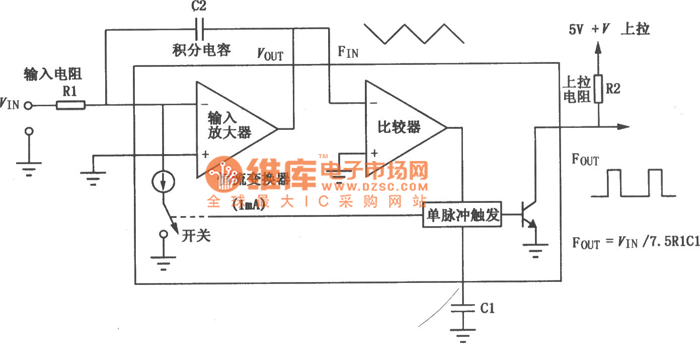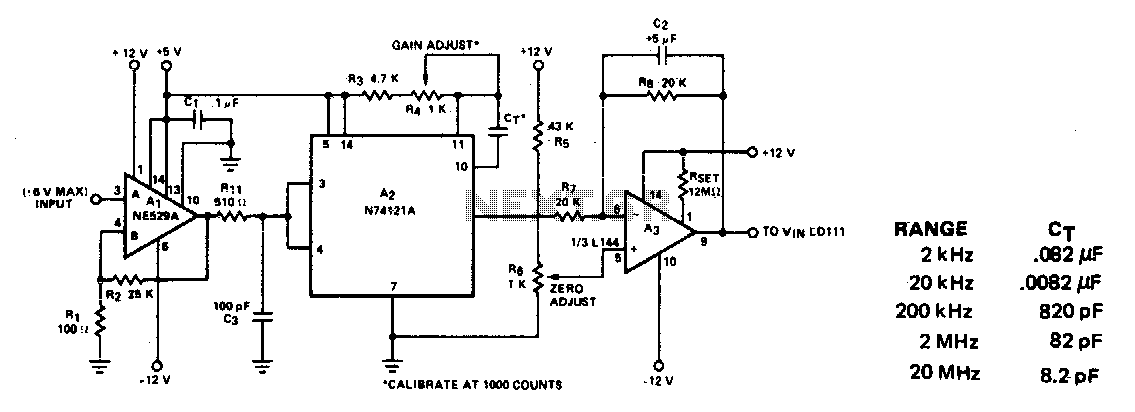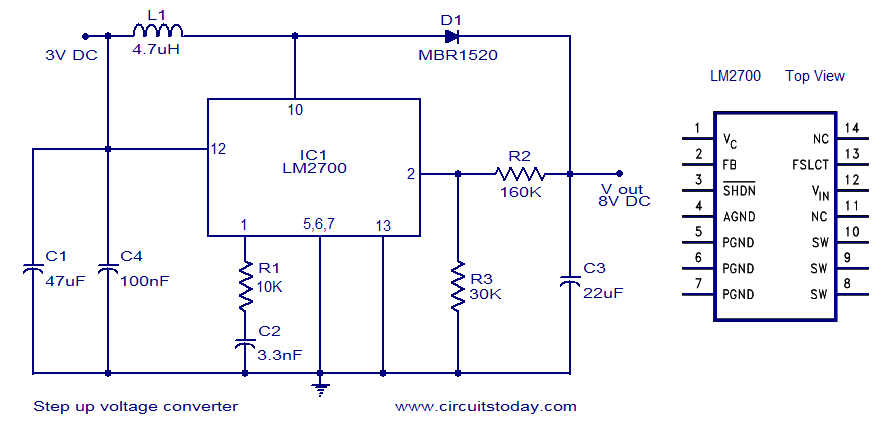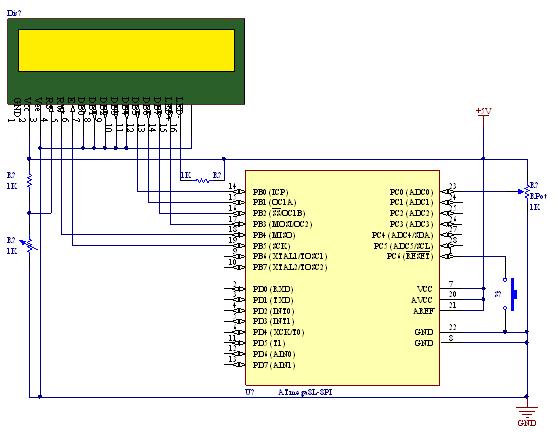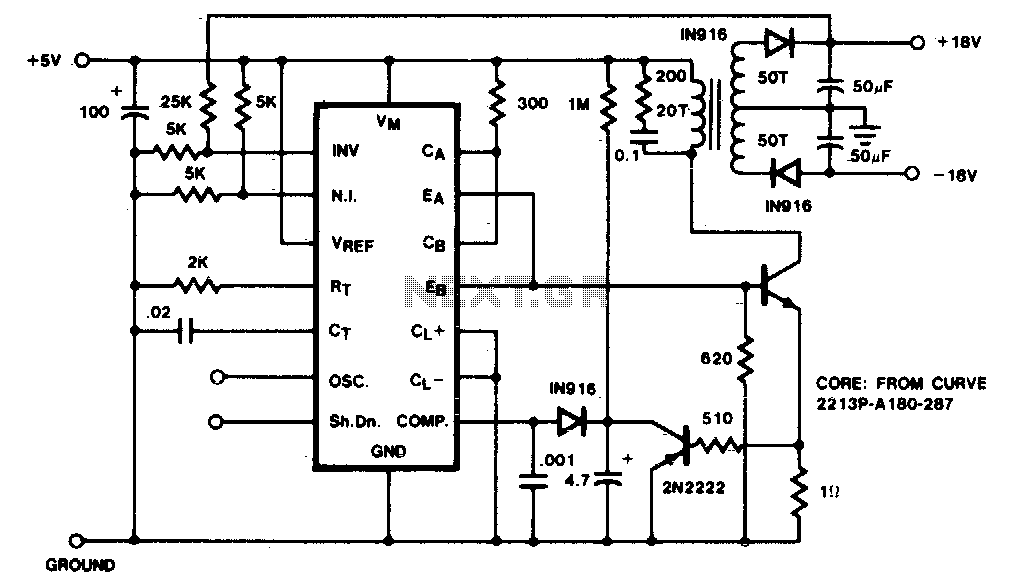
Temperature-to-frequency converter
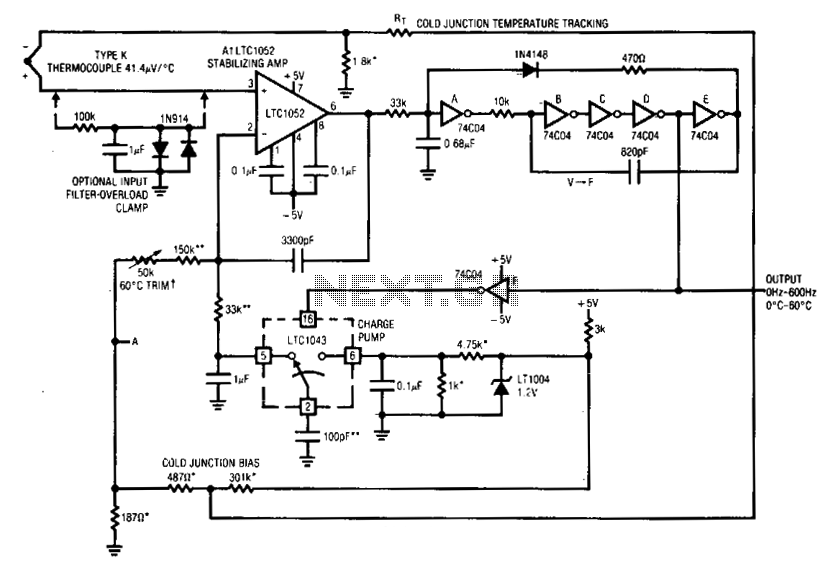
Al's positive input is biased by the thermocouple. Al's output drives a basic voltage-to-frequency (V-F) converter, which consists of 74C04 inverters and related components. Each V-F output pulse results in a fixed amount of charge being transferred from a 100 pF capacitor to a 1 µF capacitor via an LT1043 switch. The larger capacitor integrates the charge packets, generating a direct current (DC) voltage at Al's negative input. Al's output compels the V-F converter to operate at the frequency necessary to balance the inputs of the amplifier. This feedback mechanism mitigates drift and nonlinearities in the V-F converter as an error factor, making the output frequency dependent solely on the DC conditions at Al's inputs. The 3300 pF capacitor creates a dominant response pole at Al, which stabilizes the loop.
In this electronic circuit, Al's positive input, influenced by the thermocouple, serves as a critical reference point for the operation of the voltage-to-frequency (V-F) converter. The 74C04 inverters function as the core of the converter, transforming the analog voltage signal into a frequency output. The design incorporates a feedback loop that ensures the stability and accuracy of the system.
The 100 pF capacitor acts as a charge reservoir, releasing a fixed charge to the 1 µF capacitor during each pulse generated by the V-F converter. The LT1043 switch plays a vital role in controlling the transfer of charge between these capacitors, ensuring that the integration process occurs smoothly. The integration of charge in the larger capacitor results in a DC voltage that is fed back to the negative input of Al, creating a balance between the amplifier's inputs.
The feedback mechanism is crucial in eliminating drift and reducing nonlinearities, which can introduce errors in the output frequency. The output frequency is thus a direct reflection of the steady-state DC conditions at Al's inputs, emphasizing the importance of precise input biasing.
To enhance the stability of the circuit, a 3300 pF capacitor is employed, which establishes a dominant response pole at Al. This component is essential for controlling the frequency response of the feedback loop, ensuring that the system remains stable under varying conditions. The careful selection of these components and their arrangement within the circuit contributes to the reliable performance of the V-F converter, making it suitable for applications requiring accurate frequency generation from voltage signals.Al's positive input is biased by the thermocouple. Al's output drives a crude V — F converter, comprised of the 74C04 inverters and associated components. Each V — F output pulse causes a fixed quantity of charge to be dispensed into the 1 µ¥ capacitor from the 100 pF capacitor via the LT1043 switch.
The larger capacitor integrates the packets of charge, producing a dc voltage at Al's negative input. Al's output forces the V-* F converter to run at whatever frequency is required to balance the amplifier's inputs.
This feedback action eliminates drift and nonlinearities in the V — F converter as an error item and the output frequency is solely a function of the dc conditions at Al's inputs. The 3300 pF capacitor forms a dominant response pole at Al, stabilizing the loop. 🔗 External reference
In this electronic circuit, Al's positive input, influenced by the thermocouple, serves as a critical reference point for the operation of the voltage-to-frequency (V-F) converter. The 74C04 inverters function as the core of the converter, transforming the analog voltage signal into a frequency output. The design incorporates a feedback loop that ensures the stability and accuracy of the system.
The 100 pF capacitor acts as a charge reservoir, releasing a fixed charge to the 1 µF capacitor during each pulse generated by the V-F converter. The LT1043 switch plays a vital role in controlling the transfer of charge between these capacitors, ensuring that the integration process occurs smoothly. The integration of charge in the larger capacitor results in a DC voltage that is fed back to the negative input of Al, creating a balance between the amplifier's inputs.
The feedback mechanism is crucial in eliminating drift and reducing nonlinearities, which can introduce errors in the output frequency. The output frequency is thus a direct reflection of the steady-state DC conditions at Al's inputs, emphasizing the importance of precise input biasing.
To enhance the stability of the circuit, a 3300 pF capacitor is employed, which establishes a dominant response pole at Al. This component is essential for controlling the frequency response of the feedback loop, ensuring that the system remains stable under varying conditions. The careful selection of these components and their arrangement within the circuit contributes to the reliable performance of the V-F converter, making it suitable for applications requiring accurate frequency generation from voltage signals.Al's positive input is biased by the thermocouple. Al's output drives a crude V — F converter, comprised of the 74C04 inverters and associated components. Each V — F output pulse causes a fixed quantity of charge to be dispensed into the 1 µ¥ capacitor from the 100 pF capacitor via the LT1043 switch.
The larger capacitor integrates the packets of charge, producing a dc voltage at Al's negative input. Al's output forces the V-* F converter to run at whatever frequency is required to balance the amplifier's inputs.
This feedback action eliminates drift and nonlinearities in the V — F converter as an error item and the output frequency is solely a function of the dc conditions at Al's inputs. The 3300 pF capacitor forms a dominant response pole at Al, stabilizing the loop. 🔗 External reference
